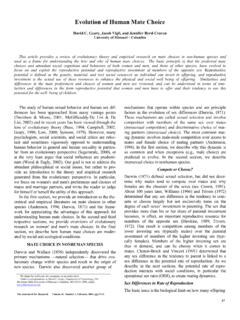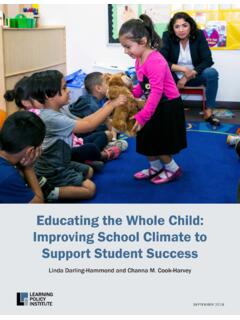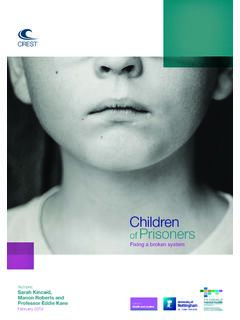Transcription of 2021 consumer products industry outlook - Deloitte
1 2021 consumer products industry outlookNo-regret moves in the face of uncertainty2021 consumer products industry outlook : No-regret moves in the face of uncertainty2 IntroductionWe begin the year confronted by several seemingly contradictory realities. The overall macroeconomic environment faces continued headwinds, yet the outlook for the consumer products (CP or CPG) industry is relatively bright. More specifically, the service economy continues to suffer, but consumers are shifting their unspent money toward buying more goods. Even within CPG, there are winners and losers based on how well-positioned companies are to meet the needs of the continued at-home consumption trend. It is a complex and uncertain environment making navigation even more fraught than there is good reason to be optimistic, even enthusiastic, toward the prospects for growth in this year s outlook , consumer products companies should proceed with appropriate care.
2 However, after scenario analysis and connecting with an external panel of industry executives, we identify five no-regret strategic moves that we feel represent the direction of the industry in 2021. Specifically, consumer products companies are: Resetting go-to-market strategies, Accelerating the shift to digital, Building supply chain resilience, investing in tomorrow s business foundations, and Connecting purpose to methodologyDeloitte consumer products industry specialists defined and scenario-tested several dozen strategic actions with the intention of identifying a core set that proved valuable in all scenarios. This year, we sought additional external testing and confirmation for our views. These actions and other concepts were further evaluated through a purpose-built, external survey of senior executives at 55 consumer products companies. The combined analysis uncovered five themes that represent the core direction of the consumer products industry in 2021.
3 We call them no-regret moves because they are actions that have strategic merit regardless of how the future consumer products industry outlook : No-regret moves in the face of uncertainty3 Macroeconomic contextTo understand the direction of the consumer products sector and how these no-regret moves fit, it helps to start with the overall economic environment. How 2021 will play out is predicated on a variety of factors, including COVID-19 vaccine deployment, safety restrictions, fiscal support, state and local government coffers, the persistence of virtual schooling and work, and even consumer psychology and the stickiness of new habits. Various assumptions about the timing, degree, and/or effectiveness of all the above make for different scenarios regarding consumer spending in is what we know and believe about the near term. Personal consumption expenditure (the mainstay of the economy) is still lower than it was in Q4 20191 and is likely to be weighed down in the near term by weak economic activity, high unemployment, and overall uncertainty about the pandemic itself.
4 However, not all sectors are experiencing the downturn in the same way, and a pandemic-damaged economy can still be a good one for many CPG companies. Continuing from last year, there is a tangible shift in consumer spending from services to goods. With key spending avenues such as food places, travel, transportation, and theaters out of favor due to health concerns, consumers are instead increasing spending on goods. So far, durable goods are the biggest winners, but sales of nondurable goods are growing as years of focusing on efficiency, revenue growth is now the No. 1 objective of consumer products executivesIn our baseline scenario for the second half, the story A key to economic growth in 2021 and 2022 is distribution to and acceptance of COVID-19 vaccines by the wider US population. Economic activity and wider consumer spending are likely to pick up as a result. Accordingly, we expect the US economy to expand in 2021 after a contraction in the year, positive or negative surprises could expedite or prolong the recovery and represent other, credible scenarios that are part of our analysis.
5 But the consumer products industry itself enters 2021 with ambition and confidence. After years of focusing on efficiency, revenue growth is now the No. 1 objective of consumer products executives in our survey. And they think they can achieve it. Four in five of those CPG executives are confident in their organization s ability to execute its business strategy in the coming state of the consumerThe buying behavior of consumers changed significantly during the pandemic, and those behaviors are likely to persist throughout much of 2021. Namely, the trend toward at-home consumption will likely continue. Executives see consumers simplifying their lifestyles (around 80%) and retreating into the home (65%). Almost universally (95%), they see the work-from-home trend continuing for consumers. Executives predict that the top purchase drivers will be health and safety (92%), trust (92%), and quality (88%).As 2020 ended, Deloitte s Global State of the consumer Tracker showed that more than a third of consumers still did not feel safe participating in everyday activities such as shopping in stores, while around 40% were willing to pay a premium for convenience, which was primarily driven by a desire to maintain safety.
6 And there was, of course, a move to online shopping channels for both delivery and pickup. Seven in 10 executives said consumers are not going to return to prepandemic in-store shopping patterns in 2021, but that could change with successful consumer health concerns are high and universally felt, the financial aspects of the pandemic are experienced unevenly. For instance, younger consumers are much more likely to say they are worried about making upcoming payments or that they are putting off large Labor market conditions are playing a part. Despite generally improving since April, unemployment is still high entering 2021, and many of those who are employed remain wary about their economic prospects. The bifurcation of consumers, who in many ways live in different financial worlds, is likely to continue regardless of any relief on the health consumer products industry outlook : No-regret moves in the face of uncertainty4 Direction of the industryWith this economic backdrop and the context of the changing consumer in mind, CPG companies recognize they should navigate the road ahead with care.
7 As mentioned earlier, there is much reason for optimism, and companies will address their individual circumstances in a variety of ways. But the direction of the industry in 2021 will likely be characterized by the following five no-regret go-to-market strategiesConsumers changed their behavior and preferences, so companies are changing their go-to-market strategies and capabilities to match. industry players are adjusting how they segment consumers, prioritize channels, establish product portfolios, position their brands, and deploy service models. This work continues in the new year. Four in five companies indicate that resetting their go-to-market strategy is critical to meeting their 2021 objectives, but only half rated the current maturity of their related capabilities as high. As a result, the vast majority indicated go-to-market is a top investment not surprisingly, the first priority is adapting to the sudden shifts in channel preference spurred on by the pandemic.
8 Through regulation or preference, consumers aren t shopping in stores, frequenting restaurants, or commuting to work to support downtown channels at the same rate. Instead, they are getting their food and other goods where they can one-stop shop and seeking the convenience, safety, and availability offered by online channels all related to the overarching at-home consumption trend. More than half of CPG companies see increased reliance on online and omnichannel as a means of reaching and engaging consumers. This is true even in areas like food and beverage, where historically the penetration of e-commerce has been low. Here, Unilever s Ice Cream Now is notable for its success on multiple digital platforms, including integrated sales through Uber Eats and other popular app-based restaurant delivery Brand-building is accelerating its shift online, too, and CPG companies should embrace digital-first may also be direct-to- consumer s (DTC) liminal moment.
9 Like retailers encroaching onto name-brand turf with private labels, the CP industry is making moves to directly sell to consumers. One in three executives say their companies are shifting focus to DTC channels. One example is Perdue Farms, which, with fortuitous timing, launched its DTC channel just three months ahead of COVID-19 lockdowns in the United States; DTC has continued to expand as a strategic priority for the Executives who are making DTC part of their strategy say they are prioritizing development of related DTC marketing ( , content, digital campaign management, social activation) and supply chain ( , shipping-friendly packaging, warehousing and fulfillment) consumer products industry outlook : No-regret moves in the face of uncertainty5 This move to DTC is true both for companies that did well and those that lost revenue during the initial wave of the pandemic, but the latter group has an additional set of priorities.
10 Those who lost revenue are twice as likely to say they need to resegment their consumer base and develop a completely new go-to-market strategy. In 2021, they will likely continue to rationalize their product offerings by reducing the number of SKUs produced and sold. Many are also seeking diversification into offerings that better fit the at-home trend. They will likely spend 2021 designing new products and introducing new service offerings to meet the is worth noting that, for CP companies to be successful in these pursuits, they should develop their data intelligence capabilities to anticipate and identify demand shifts. There is too much volatility and uncertainty not to wire these improved go-to-market systems with better headlights for strategic decisions and triggers for faster action. And, like with e-commerce channels, those companies looking to diversify and create new revenue streams should make sure they have the right digital and supply chain capabilities in place to support strategy differences among companies with Q2 2020 revenue increase versus decreaseSource: Deloitte analysis of a survey of consumer products executives, November product offerings by reducing the number of SKUs produced and sold 60%50%Design new product offeringsIntroduce new services ( , subscriptions, digital enhancements) Resegment shoppers and develop a completely new go-to-market strategy 40%60%30%44%10%36%10%24%Q2 2020 revenue increasedQ2 2020 revenue decreased2021 consumer products industry outlook : No-regret moves in the face of uncertainty6 Accelerating the shift to digitalPeople will see the words digital acceleration in almost everything they read this year, but that makes them no less true.

















